Some daily sky sights among the ever-changing stars and planets.
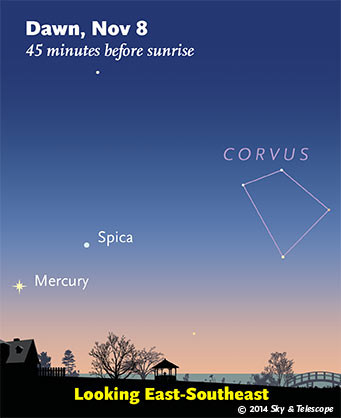
Friday, November 7
The Moon, just past full, rises in the east at dusk. Once it climbs high, look for orange Aldebaran to its lower left and the Pleiades to its upper left.
Catch Mercury in Saturday's dawn, as shown here.
Saturday, November 8
The waning gibbous Moon rises around the end of evening twilight. Look for Aldebaran not very far to its upper left. Higher above Aldebaran are the Pleiades.
Sunday, November 9
By mid-evening the waning Moon is up in the east. Look to its lower left for orange Betelgeuse, the left corner of rising Orion. Higher to the Moon's upper right is orange Aldebaran. Even farther to the Moon's upper left shines Capella. The Moon itself is at the very dim top of Orion's Club.
Monday, November 10
By 8 p.m. now, Great Square of Pegasus stands in its level position very high toward the south. Its right side points far down toward Fomalhaut. Its left side points less far down more or less toward Beta Ceti.
If you have an open view to a dark south horizon, and if you're no farther north than roughly New York or Denver, picture an equilateral triangle with Fomalhaut and Beta Ceti forming its top two corners. Near where the third corner would be is Alpha Phoenicis, or Ankaa, in Phoenix. It's magnitude 2.4, not very bright but the brightest thing in the area. Have you ever seen a star of Phoenix before?
Tuesday, November 11
Very high now in the north, in the fall Milky Way, is dim Cepheus, husband in myth to brighter Cassiopeia. Its constellation pattern hosts two landmark variable stars, Delta (δ) and Mu (μ) Cephei, for binoculars or even the naked eye. Delta is the prototype Cepheid. Mu is one of the largest stars known. See Gary Seronik's Binocular Highlight column and chart in the November Sky & Telescope, page 45.
Wednesday, November 12
Now that the waning Moon doesn't rise until about 10 p.m., evening is for deep-sky observing again. If your scope is big enough and your sky dark enough to show 12th- or 13th-magnitude galaxies (maybe within reach of a 6- or 8-inch scope in the exurbs), see how many galaxies you can log inside the Circlet of Pisces using Ken Hewitt-White's Going Deep column and chart in the November Sky & Telescope, page 60.
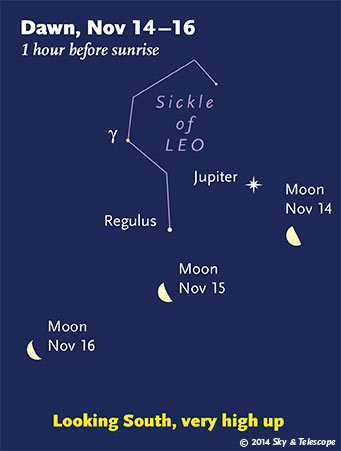
Thursday, November 13
Jupiter and the waning Moon shine high in the south in early dawn Friday morning the 14th, with fainter Regulus to their left, as shown here. Although they look close together, Jupiter is 2,600 times farther than the Moon, and Regulus is 950,000 times farther than Jupiter.
Friday, November 14
Last-quarter Moon (exact at 10:16 a.m. EST). The Moon rises around midnight tonight with Jupiter to its left (for North America.) By dawn Saturday morning the 15th, the Moon is below Regulus with Jupiter now high to their upper right.
Saturday, November 15
Mars is right over the handle of the Sagittarius Teapot as twilight fades and the stars come out, as shown in the last illustration below. Binoculars will help.
________________________________
Want to become a better astronomer? Learn your way around the constellations. They're the key to locating everything fainter and deeper to hunt with binoculars or a telescope.
This is an outdoor nature hobby; for an easy-to-use constellation guide covering the whole evening sky, use the big monthly map in the center of each issue of Sky & Telescope, the essential guide to astronomy. Or download our free Getting Started in Astronomy booklet (which only has bimonthly maps).

Once you get a telescope, to put it to good use you'll need a detailed, large-scale sky atlas (set of charts). The standards are the little Pocket Sky Atlas, which shows stars to magnitude 7.6; the larger and deeper Sky Atlas 2000.0 (stars to magnitude 8.5); and once you know your way around, the even larger Uranometria 2000.0 (stars to magnitude 9.75). And read how to use sky charts with a telescope.
You'll also want a good deep-sky guidebook, such as Sue French's Deep-Sky Wonders collection (which includes its own charts), Sky Atlas 2000.0 Companion by Strong and Sinnott, the bigger Night Sky Observer's Guide by Kepple and Sanner, or the beloved if dated Burnham's Celestial Handbook.
Can a computerized telescope replace charts? Not for beginners, I don't think, and not on mounts and tripods that are less than top-quality mechanically (able to point with better than 0.2° repeatability, which means fairly heavy and expensive). As Terence Dickinson and Alan Dyer say in their Backyard Astronomer's Guide, "A full appreciation of the universe cannot come without developing the skills to find things in the sky and understanding how the sky works. This knowledge comes only by spending time under the stars with star maps in hand."
This Week's Planet Roundup
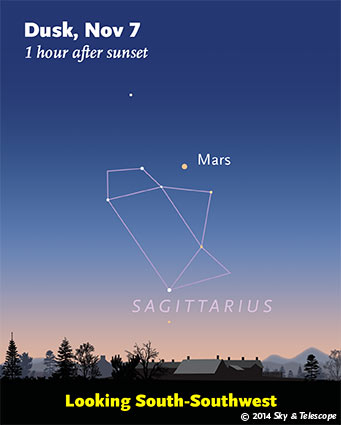
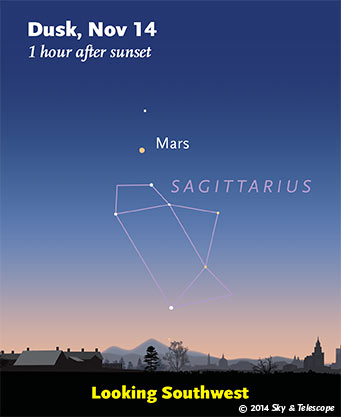
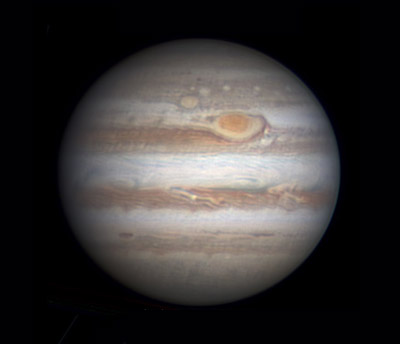
Mercury is coming down from its best dawn apparition of 2014 (for mid-northern latitudes), but it remains as bright as ever at magnitude –0.8. Look for it low above the eastern horizon in mid-dawn, as shown at the top of this page. Don't confuse it with fainter Spica to its upper right, or with Arcturus much farther to its upper left.
Venus remains hidden the glare of the Sun.
Mars (magnitude +0.9) remains in the southwest during and after twilight; it sets around 8 p.m. local time. Look for it far below Altair.
Jupiter (magnitude –2.0, in western Leo) rises in the east-northeast around 11 or midnight. About 40 minutes later, Regulus (magnitude +1.4) rises below it. By dawn they shine high in the south, with Regulus now to Jupiter's left.
Saturn is hidden in the glare of the Sun.
Uranus (magnitude 5.7, in Pisces) and Neptune (magnitude 7.9, in Aquarius) are high in the southeast and south, respectively, shortly after dark. See our finder charts for Uranus and Neptune online or in the September Sky & Telescope, page 50.
________________________________
All descriptions that relate to your horizon — including the words up, down, right, and left — are written for the world's mid-northern latitudes. Descriptions that also depend on longitude (mainly Moon positions) are for North America.
Eastern Standard Time (EST) is Universal Time (UT, UTC, or GMT) minus 5 hours.
________________________________
“This adventure is made possible by generations of searchers strictly adhering to a simple set of rules. Test ideas by experiments and observations. Build on those ideas that pass the test. Reject the ones that fail. Follow the evidence wherever it leads, and question everything. Accept these terms, and the cosmos is yours.”
— Neil deGrasse Tyson, 2014.
 0
0
Comments
You must be logged in to post a comment.